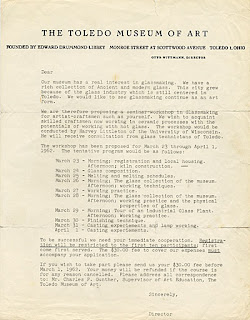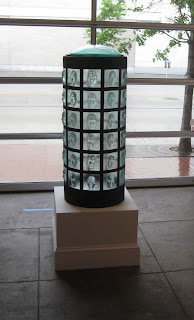>
During the 1950s, studio ceramics and other craft media in the U.S. began to gain in popularity and importance, and artists interested in glass looked for new paths outside industry sources. At that time, access to glass was only through industrial production. Students were not taught hands-on techniques with the material; the craft of working with hot glass was still taught at the factories, under the apprenticeship system. The catalyst for the development of studio glass was Harvey Littleton, a teaching ceramist at the University of Wisconsin in Madison.
Informed by his own background in the material (he grew up in the shadow of Corning Glassworks, where his father headed Research and Development during the 1930’s), Harvey started experimenting with hot glass in his studio in 1958. He eventually realized that his desire to develop studio glassblowing could become a reality after experiencing limited success with his own glassblowing experiments.
The 1962 Toledo Workshop program
Harvey joined forces with the Toledo Museum of Art, the site of the “birth” of the American Studio Glass movement during two historic glassblowing workshops in 1962. He worked with glass research scientist Dominick Labino, who successfully devised a small, inexpensive furnace in which glass could be melted and worked, making it affordable and possible for the first time for artists to blow glass in independent studios.
Harvey Littleton subsequently started a glass program at the University of Wisconsin in Madison, and some of his early students were Dale Chihuly, Marvin Lipofsky, and Fritz Dreisbach, all artists who have played seminal roles in raising the awareness of studio glass around the world.Source: CMOG
As GlassWeekend 2011 gets started, The Washington Glass School Blog visited with Harvey’s daughter Maurine Littleton at her art gallery in Washington, DC, as she prepared for the exhibition. Maurine brought out some of the early glass pieces made by Harvey at the workshops.
Maurine Littleton discusses the early Harvey Littleton pieces. In the background are Harvey Littleton works ca 1986.
Two Harvey Littleton vases from the 1962 Toledo workshop. The pieces are engraved on the bottom with Harvey’s name and date.
Harvey’s first pieces in blown glass were, like his earlier works in pottery, functional forms: vases, bowls and paperweights. His breakthrough to non-functional form came in 1963 when, with no purpose in mind, he remelted and finished a glass piece that he had earlier smashed in a fit of anger. The object lay in his studio for several weeks before he decided to grind the bottom. As Harvey recounts in his 1971 book Glassblowing: A Search for Form, he brought the object into the house where “it aroused such antipathy in my wife that I looked at it much more closely, finally deciding to send it to an exhibition. Its refusal there made me even more obstinate, and I took it to New York … I later showed it to the curators of design at the Museum of Modern Art. They, perhaps relating it to some other neo-Dada work in the museum, purchased it for the Design Collection.”
Harvey’s birthday is June 14th – he turns 89 this year. Everyone here at the Washington Glass School sends Harvey Best Wishes for a Happy Birthday!
The Smithsonian Institution has a fascinating oral history interview with Harvey – made in 2001. Click HERE to jump to the SI web-link.
Washington Post asks "Is Glass Only Pretty?"
>
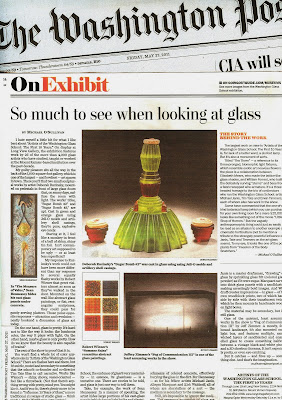 Washington Post reviews Washington Glass School 10th Anniversary Show at Long View Gallery
Washington Post reviews Washington Glass School 10th Anniversary Show at Long View Gallery
The Washington Post newspaper arts critic Michael O’Sullivan has a lengthy review of the Long View Gallery 10th Anniversary exhibition : Artists of the Washington Glass School – The First 10 Years. Michael finds artworks that move him and question if contemporary art must be ugly – if only to be less superficial.
In his review of the retrospective show, Michael O’Sullivan writes: “On the one hand, glass is pretty. It’s hard not to like the way it looks: the luminous color, the way it plays with light. On the other hand, maybe glass is only pretty. How do we know that the beauty is also capable of brains? The rest of the show is proof that it is”…“For the artists of the Washington Glass School, the embrace of glass’s very materiality — in essence, its glassiness — is a tentative one. There are stories to be told, and glass is just one way to tell them.”…
 Jeff Zimmer “Fog Of Communication III” photo by anythingphoto.net
Jeff Zimmer “Fog Of Communication III” photo by anythingphoto.net
And of artist Jeff Zimmer’s work, Michael writes:
“One of the quietest, least assuming works in the show is “Fog of Communication III” by Jeff Zimmer. A moody, fog-bound landscape, it’s also mounted on a light box, and features multiple, sandwiched layers of sandblasted and enamelled glass to create something halfway between a vintage black-and-white photo and a 3D shoebox diorama. It isn’t especially pretty, or even eye-catching.
But it catches — and fires up — something else. And that’s the imagination. “
Click HERE to jump to the full Washington Post article.
The Washington Post also goes into the background story of one of the largest works in the show – “The Three” by Elizabeth Ryland Mears and William “Tex” Forrest.
 Elizabeth Ryland Mears with William Forrest “The Three” photo by anythingphoto.net
Elizabeth Ryland Mears with William Forrest “The Three” photo by anythingphoto.net
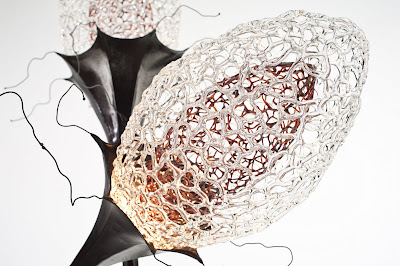 Michael writes “But the vaguely anthropomorphic thing could just as easily be read as an allusion to another example of cinematic horticulture (not to mention a tribute to the strangely powerful influence of Janis, Tate and Timmers on the art-glass scene). To my eye, it looks like one of the pod plants from “Invasion of the Body Snatchers.”
Michael writes “But the vaguely anthropomorphic thing could just as easily be read as an allusion to another example of cinematic horticulture (not to mention a tribute to the strangely powerful influence of Janis, Tate and Timmers on the art-glass scene). To my eye, it looks like one of the pod plants from “Invasion of the Body Snatchers.”
Click HERE to jump to the full Washington Post description of the Liz Mears / Tex Forrest work
 Jennifer Lindstrom What is Home?
Jennifer Lindstrom What is Home?
Click HERE to jump to the Washington Post’s photo gallery of some of the works in the show.
The WGS 10th anniversary show at Long View Gallery will be on exhibit until June 19, 2011.
Featured artists include: Tim Tate, Michael Janis, Erwin Timmers, Elizabeth Mears, Syl Mathis, Lea Topping, Robert Kincheloe, Alison Sigethy, Dave D’Orio, Anne Plant, Jeffery Zimmer, Teddie Hathaway, Jackie Greeves, Kirk Waldroff, Debra Ruzinsky, Tex Forrest, Diane Cabe, Robert Wiener, Nancy Donnelly, Sean Hennessey, Cheryl Derricotte, Jennifer Lindstrom, Michael Mangiafico, Allegra Marquart and m.l.duffy.
There is an artist talk on Sunday, June 05, from 3-4 pm. There is a 10 Year Anniversary celebration that will be held at the Long View Gallery, Sunday, June 19, from 2-5 pm.
Washington Glass School: The First 10 Years
LongView Gallery
1234 9th Street, NW, Washington, DC
Installing Washington Glass School @ Long View Gallery
>The installation of the Washington Glass School retrospective at Long View Gallery’s incredible space has begun.
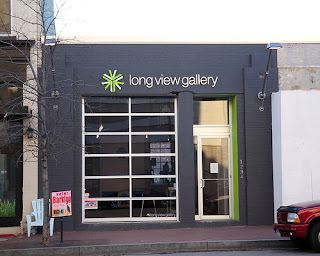
Long View Gallery, 1234 9th Street, NW Washington, DC
L-R Robert Wiener & Sean Hennessey‘s works installed and looking good.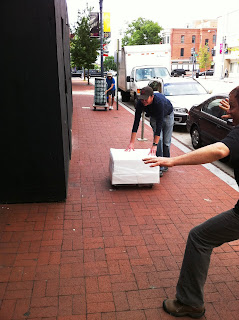
m. l. duffy’s glass & steel sculpture comes rolling up 9th. Erwin Timmers directs the sidewalk traffic to make delivery… easier.
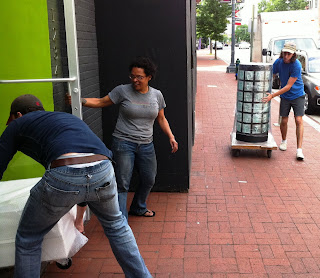
Jennie Lindstrom helps out the crew.
m. l. duffy’s cast glass and steel piece located at the front of the gallery.
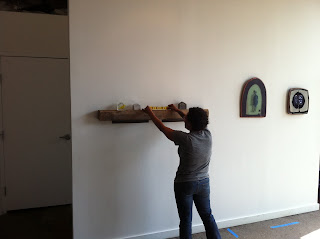
Jennie then gets working on her artwork installation – next to glass artwork by Jackie Greeves.
Washington Glass School: The First 10 Years
Long View Gallery
1234 9th Street, NW, Washington, DC
May 19 – June 19, Opening Reception, May 19th, 6:30-8:30 PM
Closing Reception Sunday June 19, 2-5 PM
phone: 202.232.4788

